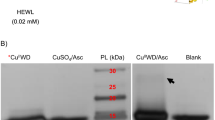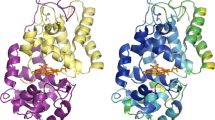Abstract
Biotechnology is consistently seeking improved enzyme stability. Enzymes have great properties, although their marginal stability limits their applications. Among the strategies for improving stability of the enzymes, chemical modification is a simple and effective technique. In the present study, chemical modification of horseradish peroxidase (HRP) was carried out with 2,3-dichloromaleic anhydride and 2,3-dimethylmaleic anhydride. HRP is an important heme-containing enzyme. It is widely applied in pharmacological, chemical, and medical industries. Here, thermal stability of HRP was investigated at different temperatures. In addition, the enzyme stability was evaluated in urea, DMSO, alkaline pH, and hydrogen peroxide solutions by spectroscopic techniques. Structural investigation indicated that the both anhydrides slightly decrease compactness of the enzyme structure. The results also indicated that 2,3-dichloromaleic anhydride increases thermal stability of the enzyme and its stability in urea and DMSO solutions, but 2,3-dimethylmaleic anhydride only stabilizes HRP in urea solution. Furthermore, the experiments implied that none of the modifiers are effective on the stability of HRP in extreme pH and oxidative condition. Catalytic efficiency and activation energy did not change remarkably following reaction of the enzyme with the both carboxylic anhydrides. Consequently, improvement in the stability of HRP depends on not only the type of modifier but also denaturing condition.





Similar content being viewed by others
References
Mateo, C., Palomo, J. M., Fernandez-Lorente, G., Guisan, J. M., & Fernandez-Lafuente, R. (2007). Enzyme and Microbial Technology, 40, 1451–1463.
Iyer, P. V., & Ananthanarayan, L. (2008). Process Biochemistry, 43, 1019–1032.
Fagain, C. (2003). Enzyme and Microbial Technology, 33, 137–149.
DeSantis, G., & Jones, J. B. (1999). Current Opinion in Biotechnology, 10, 324–330.
Mozhaev, V. V., Melik-nubarov, N. S., Siksnis, V., & Martinek, K. (1990). Journal Biocatalysis and Biotransformation, 3, 189–196.
Vinogradov, A. A., Kudryashova, E. K., Grinberg, V. Y., Grinberg, N. V., Burova, T. V., & Levashov, A. L. (2001). Protein Engineering, 14, 683–689.
Xue, Y., Wu, C., Xue, Y., Wu, C. Y., Branford-White, C. J., Ning, X., et al. (2010). Journal of Molecular Catalysis B: Enzymatic, 63, 188–193.
Fernandez, M., Fragoso, A., Cao, R., Banos, M., & Villalonga, R. (2002). Enzyme and Microbial Technology, 31, 543–548.
Fernandez, M., Fragoso, A., Cao, R., Banos, M., Villalonga, M. L., & Villalonga, R. (2002). Biotechnology Letters, 24, 1455–1459.
Veitch, N. C. (2004). Phytochemistry, 65, 249–259.
Ngo, T. T. (2010). Analytical Letters, 43, 1572–1587.
Hassani, L. (2012). Journal of Molecular Catalysis B: Enzymatic, 80, 15–19.
Hassani, L. (2012). Applied Biochemistry and Biotechnology, 67, 489–497.
Hassani, L., Ranjbar, B., Khajeh, K., Naderi-Manesh, H., Naderi-Manesh, M., & Sadeghi, M. (2006). Enzyme and Microbial Technology, 38, 118–125.
Dixon, H. B., & Perham, R. N. (1968). Biochemical Journal, 109, 312–334.
Hermanson, G. (1996). Bioconjugate techniques. California: Academic.
Habeeb, A. F. S. A. (1966). Analytical Biochemistry, 14, 328–336.
Bubnis, W., & Ofner, C. (1992). Analytical Biochemistry, 297, 129–133.
Trinder, P. (1966). Annals of Clinical Biochemistry, 6, 24–25.
Copland, R. A. (2002). Enzymes: a practical introduction to structure, mechanism, and data analysis. New York: Wiley.
Kelly, S. M., & Price, N. C. (2000). Current Protein & Peptide Science, 1, 349–384.
Kelly, S. M., Jess, T. J., & Price, N. C. (2005). Biochimica et Biophysica Acta, 1751, 119–139.
O’Brien, A. M., & Fagain, C. O. (1996). Biotechnology Techniques, 10, 905–910.
Campbell, L. D., & Dwek, R. A. (1984). Biological spectroscopy. California: The Benjamin Cummings Publishing Company.
Carvalho, A. S., Melo, E. P., Ferreira, B. S., Neves-Petersen, M. T., Petersen, S. B., & Aires-Barros, M. R. (2003). Archives of Biochemistry and Biophysics, 415, 257–267.
Chattopadhyay, K., & Mazumdar, S. (2000). Biochemistry, 39, 263–270.
Song, H. Y., Yao, J. H., Liu, J. Z., Zhou, S. J., Xiong, Y. H., & Ji, L. N. (2005). Enzyme and Microbial Technology, 36, 605–611.
Welinder, K. G. (1979). European Journal of Biochemistry, 93, 483–502.
Gajhede, M., Schuller, D. J., Henriksen, A., Smith, A. T., & Poulos, T. L. (1997). Nature Structural Biology, 4, 1032–1038.
Mogharrab, N., Ghourchian, H., & Amininasab, M. (2007). Biophysical Journal, 92, 1192–1203.
Mozhaev, V. V., Melik-Nubarov, N. S., Levitsky, V. Y., Siksins, V. A., & Martinek, K. (1992). Biotechnology and Bioengineering, 40, 650–662.
He, Z., & Zhang, Z. (1999). Journal of Protein Chemistry, 18, 557–564.
Mozhaev, V. V., Aiksnis, V. A., Melik-Nubarov, N. S., Galkantaite, N. Z., Denis, G. J., Butkus, E. P., et al. (1998). European Journal of Biochemistry, 173, 147–154.
Ryan, O., Smyth, M. R., & Fagain, C. O. (1994). Enzyme and Microbial Technology, 16, 501–505.
Dunford, H. B. (1991). In J. Everse, K. E. Everse, & M. B. Grisham (Eds.), Peroxidases in chemistry and biology, vol. 2: horseradish peroxidase: structure and kinetic properties (pp. 1–24). Boca Raton: CRC Press.
Mozhaev, V. V., Berezin, I. V., & Martinek, K. (1988). Reviews in Biochemistry and Molecular Biology, 23, 235–281.
Wong, S. S., & Wong, L. (1992). Enzyme and Microbial Technology, 14, 866–874.
Fishman, A., Levy, I., Cogan, U., Cogan, U., & Shoseyov, O. (2002). Journal of Molecular Catalysis B: Enzymatic, 18, 121–131.
Nagano, S., Tanaka, M., Ishimori, K., Watanabe, Y., & Morishima, I. (1996). Biochemistry, 35, 14251–14258.
Lane, S. M., Kuang, Z., Yom, J., Arifuzzaman, S., Genzer, J., Farmer, B., et al. (2011). Biomacromolecules, 12, 1822–1830.
Malani, R. S., Khanna, S., & Moholkar, V. S. (2013). Journal of Hazardous Materials, 15, 256–257.
Ugarova, N. N., Rozhkova, G. D., & Berzin, I. V. (1979). Biochimica et Biophysica Acta, 570, 31–42.
Acknowledgments
Financial support for this work was provided by Research Council of Institute for Advanced Studies in Basic Sciences.
Author information
Authors and Affiliations
Corresponding author
Electronic Supplementary Material
Below is the link to the electronic supplementary material.
Fig. 1S
Irreversible thermoinactivation of non-modified (Native), dichloromaleic anhydride (Cl) and dimethylmaleic anhydride (CH3) modified forms of HRP at 55 oC, pH 7.0 (DOCX 28 kb)
Fig. 2S
Irreversible thermoinactivation of non-modified (Native), dichloromaleic anhydride (Cl) and dimethylmaleic anhydride (CH3) modified forms of HRP at 65 oC, pH 7.0 (DOCX 29 kb)
Fig. 3S
Irreversible thermoinactivation of non-modified (Native), dichloromaleic anhydride (Cl) and dimethylmaleic anhydride (CH3) modified forms of HRP at 70 oC, pH 7.0 (DOCX 38 kb)
Fig. 4S
Irreversible thermoinactivation of non-modified (Native), dichloromaleic anhydride (Cl) and dimethylmaleic anhydride (CH3) modified forms of HRP at 75 oC, pH 7.0 (DOCX 30 kb)
Fig. 5S
Irreversible thermoinactivation of non-modified (Native), dichloromaleic anhydride (Cl) and dimethylmaleic anhydride (CH3) modified forms of HRP at 80 oC, pH 7.0 (DOCX 30 kb)
Fig. 6S
Remaining activity of non-modified (Native), dichloromaleic anhydride (Cl) and dimethylmaleic anhydride (CH3) modified forms of HRP at different concentration of H2O2 (DOCX 29 kb)
Fig. 7S
Remaining activity of non-modified (Native), dichloromaleic anhydride (Cl) and dimethylmaleic anhydride (CH3) modified forms of HRP at different pH (DOCX 30 kb)
Fig. 8S
Arrehnius plot for enzymatic activity of non-modified (Native), dichloromaleic anhydride (Cl) and dimethylmaleic anhydride (CH3) modified forms of HRP, pH 7.0 (DOCX 27 kb)
Fig. 9S
Linweaver-Burk plot for non-modified (Native), dichloromaleic anhydride (Cl) and dimethylmaleic anhydride (CH3) modified forms of HRP, pH 7.0 (DOCX 32 kb)
Fig. 10S
Far-UV circular dichroism spectra of non-modified (1), dichloromaleic anhydride (2) and dimethylmaleic anhydride (3) modified forms of HRP at room temperature and pH 7.0 (DOCX 30 kb)
Fig. 11S
Intrinsic fluorescence spectra of non-modified (1) dichloromaleic anhydride (2) and dimethylmaleic anhydride (3) modified forms of HRP excited at 280 nm (DOCX 21 kb)
Fig. 12S
Stern–Volmer plot of fluorescence quenching by acrylamide for non-modified (N), dichloromaleic anhydride (Cl) and dimethylmaleic anhydride (CH3) modified forms of HRP at room temperature and pH 7.0 (DOCX 21 kb)
Rights and permissions
About this article
Cite this article
Hassani, L., Nourozi, R. Modification of Lysine Residues of Horseradish Peroxidase and Its Effect on Stability and Structure of the Enzyme. Appl Biochem Biotechnol 172, 3558–3569 (2014). https://doi.org/10.1007/s12010-014-0756-y
Received:
Accepted:
Published:
Issue Date:
DOI: https://doi.org/10.1007/s12010-014-0756-y




